Sights and Tastes of Charleston, SC, Day 1:
With the unusually warm winter and even warmer start to the spring season the flowers and trees put on their show a bit earlier this year, and I was fortunate to catch peak blooming season in Charleston, South Carolina this past weekend (Mar 23-25, 2012). Those who know me also know that I much prefer the cooler temperatures of the northern states and of Ireland, so this 8.5 hour drive to the south was a bit out of the norm for me. I made the journey on Thursday to make the most of the three-day visit. Thursday evening’s dinner at the highly recommended Fat Hen , 3140 Maybank Highway, on Johns Island serving “French cuisine with low country flourishes” was absolutely delicious. My entrée was Flounder Niciose – flounder sautéed in brown butter topped with a mixture of fresh herbs, lemon, capers, olives, and tomatoes over bacon cheese grits. That was my first introduction to grits and I was delightfully surprised at how flavorful they were.

1. While fending off mosquitoes and slathering suntan lotion, I managed to capture some glorious shots of Magnolia Plantation and Gardens Friday morning. One of the greatest thrills of the gardens were the reflections. It is my understanding that these ponds can be filled with duckweed, but on this visit the duckweed was minimal in the larger ponds and the reflections were nearly perfect. The circular pattern created by the white azalea surrounded by the pink azalea drew me to this scene. Circular patterns tend to draw the eye inward rather than lead the eye out of the photo, which is a good thing. The accent in this photo is actually the statue which was perfectly situated. If you look carefully there is a turtle in front of the statue. Note that I waited for the sun to slip behind a cloud in order to get soft even lighting on this scene. Technical details: Canon EOS 5D Mark II with Canon EF70-300mm lens at 110mm, 0.4sec at f/32, ISO 100; Manfrotto Neotech Pro Photo Tripod and ball head.
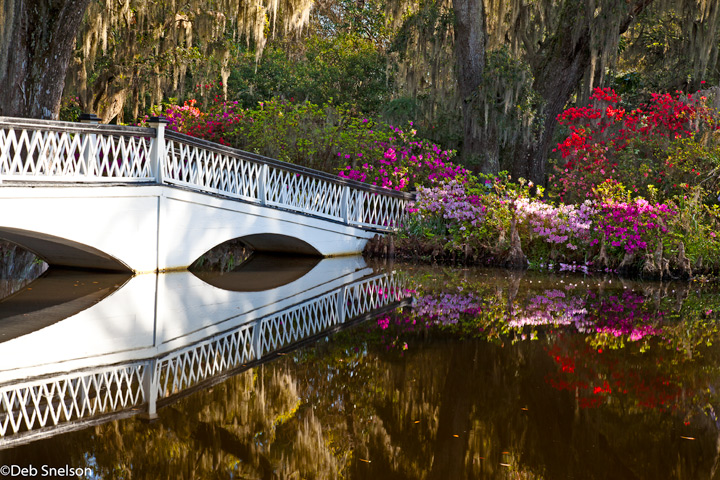
2. Bridges abound in the Magnolia Gardens . This bridge has lovely flowing lines and creates a superb reflection. The early morning light fully illuminated the trees and most of the bridge yet the flowering shrubs were still in shadow, creating a difficult scene to photograph. This photo was processed using the highlight/shadow adjustment in Photoshop to try to even out the tones. I believe the result is restful for the eyes. Notice the triangle shapes in this image. Triangles are dynamic because of the oblique lines and angles that they form, and can be stable if one side is parallel to the horizon, as are the triangles formed by the right side of the bridge (and a second by its reflection) and the azalea bushes (and their reflection). Technical details: Canon EOS 5D Mark II with Canon EF24-105mm lens at 65mm, 1/5sec at f/22, ISO 100; Manfrotto Neotech Pro Photo Tripod and ball head.
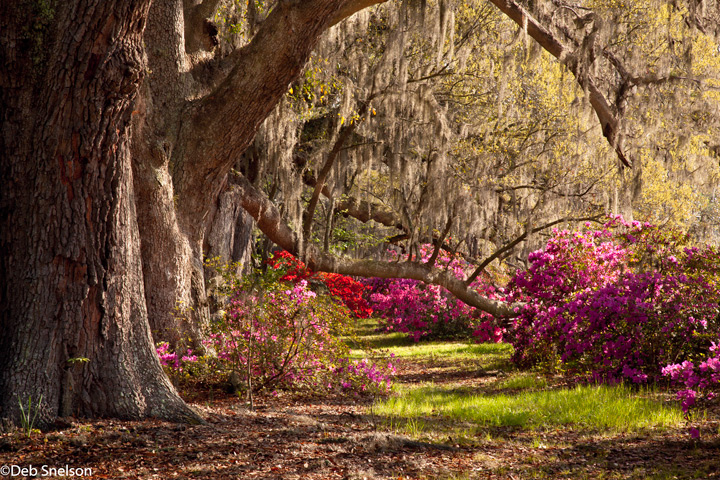
3. One of the most iconic photos of Magnolia Gardens is that of the stately trees and azaleas lining the entry roadway. In this photo I again used the circular pattern of the high-arching branch to frame the scene and trap the eye. Technical details: Canon EOS 5D Mark II with Canon EF24-105mm lens at 92mm, 1/13sec at f/20, ISO 100; Manfrotto Neotech Pro Photo Tripod and ball head.
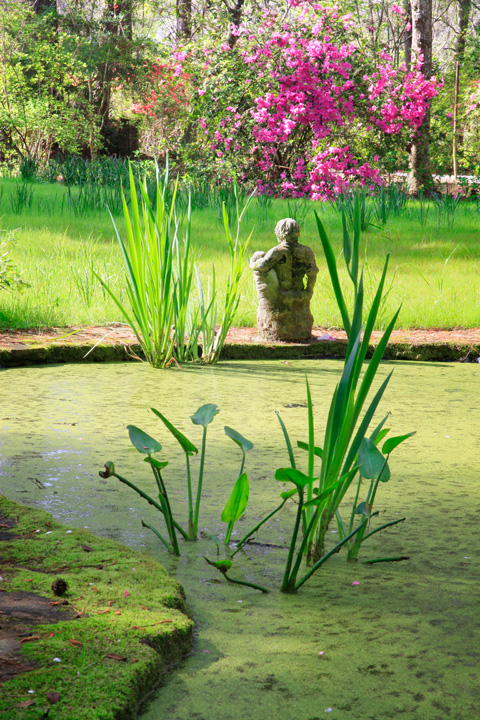
4. One of my favorite photos speaks to me of peaceful retreat, although just seconds before a young boy stepped into this small frog sanctuary as if the duckweed covered surface was just another ground covering, and his screams called for mom to jump in after him to pick him up out of the water to safe ground. I hope she brought a change of clothing for herself as well as for her son. The band of light on the grass highlighting the stone sculpture, combined with the fact that the sculpture is oriented such as to look away from the camera and towards that light are what attracted me to this intimate landscape. Technical details: Canon EOS 5D Mark II with Canon EF70-300mm lens at 110mm, 0.4sec at f/32, ISO 100; Manfrotto Neotech Pro Photo Tripod and ball head.
Lunch on Friday was at the cafe in Magnolia Gardens where I ordered a chicken salad croissant and that classic southern favorite, sweet tea. The sandwich was actually a bit better than ordinary although my hunger may have given it that extra twist.
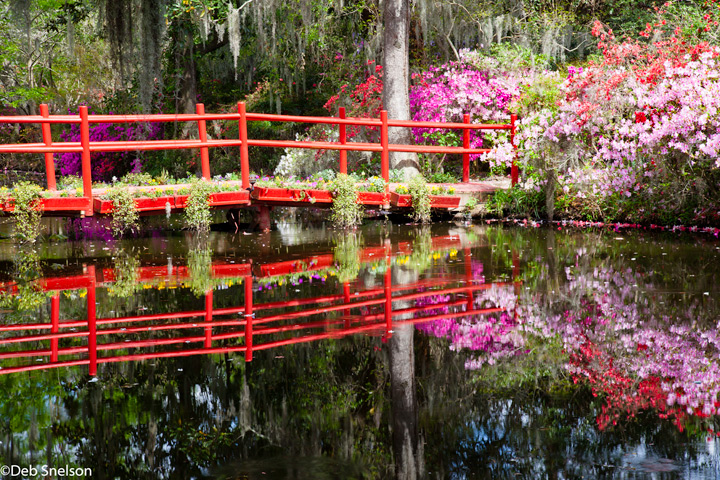
5. This red bridge and splash of azaleas were partially shaded and almost misty in the early morning. The afternoon sun was needed to bring out the full color in the flowers and to render such clarity. Fortunately the water surface remained calm throughout the day to maintain the great reflections. Standard practice is to place the horizon on the 1/3 or 2/3 grid-line using the “Rule of Thirds.”. One of the exceptions to the rule is reflections – a perfectly symmetrical image with the horizon dead center is often the most pleasing composition with a reflection. I chose to slightly emphasize the reflection in this photo to completely eliminate any sky in the photo. The sky is usually brighter than foliage and the eye can be drawn to the bright spots. You can make out the bits of sky in the reflection, but here the blue is much more pleasing and not as distracting as it would be if it were in the upper portion of the photo. Technical details: Canon EOS 5D Mark II with Canon EF24-105mm lens at 75mm, 0.24sec at f/20, ISO 100; Manfrotto Neotech Pro Photo Tripod and ball head.
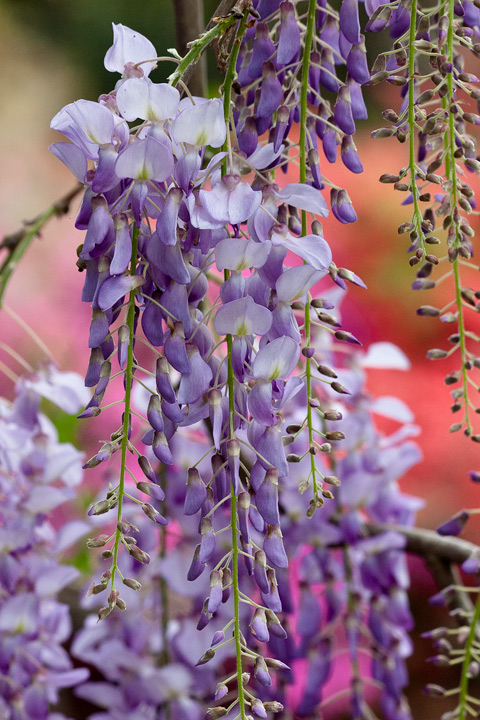
6. Getting a sharp image of flowers on a windy day can be quite challenging. For this photo of wisteria against a backdrop of azalea blossoms I had to increase my ISO to 500 in order to get a shutter speed of 1/320th of a second to freeze the motion of the dangling flowers: Technical details: Canon EOS 5D Mark II with Canon EF24-105mm lens at 110mm, 1/320sec at f/9, ISO 500; Manfrotto Neotech Pro Photo Tripod and ball head.
After a quick shower back at the Comfort Suites West of the Ashley (very comfortable accommodation) we headed out to the Shem Creek waterfront and shrimp boats in Mount Pleasant. Unfortunately many other folks had the same idea and we must have circled the parking lot 10 times before being the first to spot someone leaving a parking space. I was a bit disappointed in how few shrimp boats were actually present, and the blue moment images that I took did not have the impact that I desired. The highlight was the stand up paddle boarders, each with a small dog on the paddle board with them, that paddled out the channel and back. Dinner outside on the tikitorch-lit deck at Vickery’s Shem Creek, 1313 Shrimp Boat Lane, however, was a treat. My Lowcountry Saute was fantastic – shrimp, lump crab meat and crawfish tails sautéed in herbed bourbon butter over cheese grits topped with fried oysters – all washed down with a deliciously cold Blue Moon.

Ron Nicol
30 Mar 2012Beautiful photos, Deb. I assume you’re using a tripod given the timing on some of the shots. Why do you prefer low ISO (i.e. 100) with the longer time? I’m an amateur so I use higher ISO.
Deb Snelson
30 Mar 2012Hi Ron! Thanks for checking out my blog and thanks for pointing out that I forgot to mention that I used a tripod in all of these photos – I will amend the post now. As I’m sure you know, ISO is one of three controls you use to get the “perfect exposure”, the other two being shutter speed and aperture. The greater (higher) the ISO number (which in digital photography measures the sensitivity of the image sensor) the more sensitive your camera is to light and the larger the grain, thus the greater the amount of noise introduced into the photo. Best practice is to keep ISO at the lowest number your camera allows, which is usually 100 or 200 depending upon manufacturer, to minimize noise. Of course this is not always possible. You may need to increase shutter speed or decrease the size of the aperture (larger f stop numbers) to get the exposure you want. Low ISO is much easier to do when shooting on a tripod because the shutter can stay open longer without blur, unless, of course, the subject is moving which was what was happening with the photo of the wisteria. The wind was buffeting the dangling flowers, so I had to increase ISO to be able to increase my shutter speed to try to freeze the action while still maintaining a good exposure. I’d also increase ISO in darkly-lit rooms in order to continue shooting without using flash. So Ron – you mentioned that you were waiting for the Mark III – it’s available now and I am so envious!! With a high quality camera such as the Canon 5D you can probably get away with ISO as high as 600 to 800 and still not be bothered by the graininess of your photos, and of course there may be situations in which you may want the photos to be grainy. My preference for to keep the ISO as low as possible. Thanks for the great question!
Ron Nicol
30 Mar 2012Thanks, Deb. Very helpful. I have found the noise level of the EOS 5D at relatively high ISO to be very low. So I’m being lazy and increasing the ISO. I just got the new Mark III but haven’t had a chance to try it out yet.